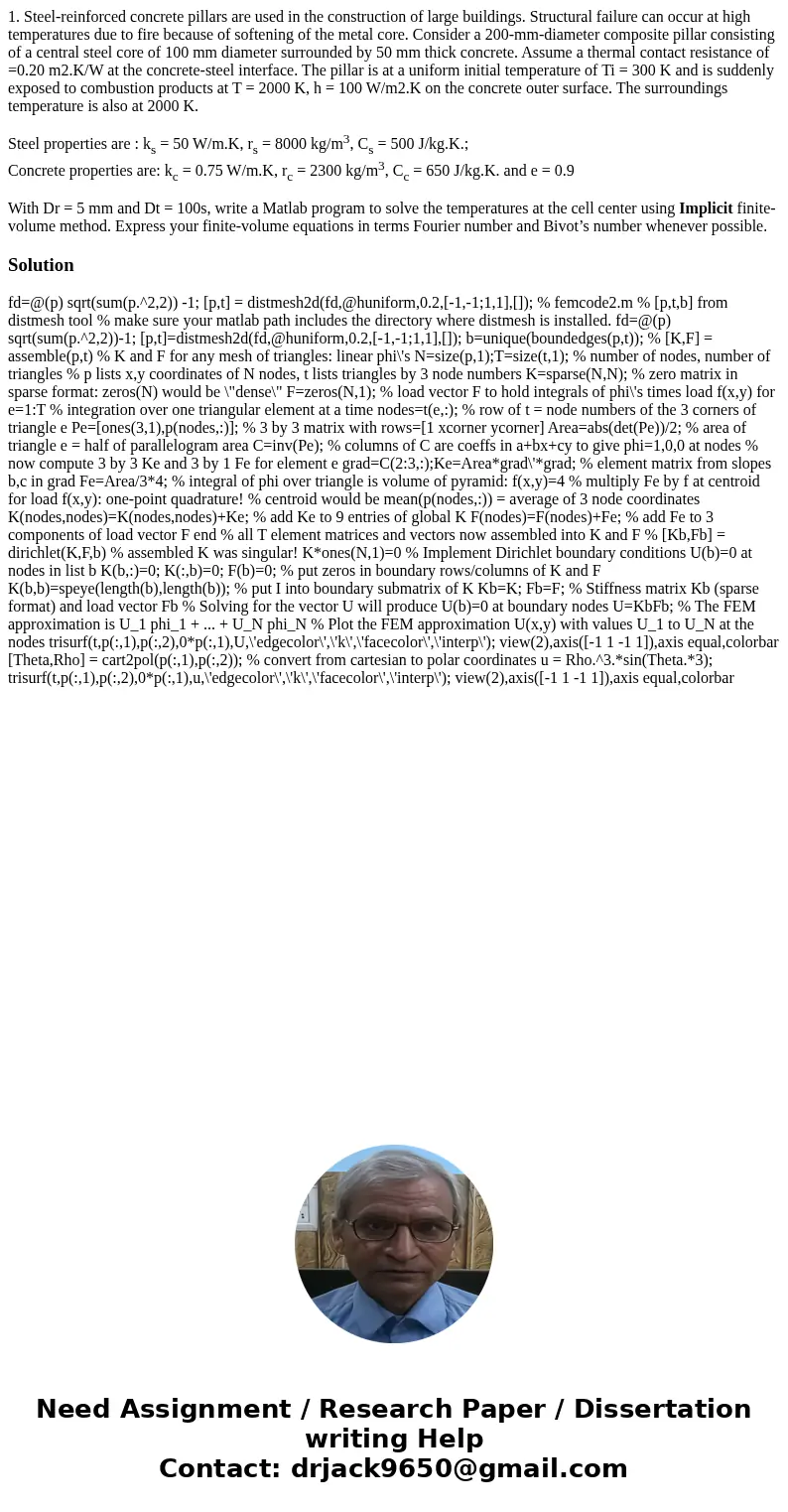1 Steelreinforced concrete pillars are used in the construct
1. Steel-reinforced concrete pillars are used in the construction of large buildings. Structural failure can occur at high temperatures due to fire because of softening of the metal core. Consider a 200-mm-diameter composite pillar consisting of a central steel core of 100 mm diameter surrounded by 50 mm thick concrete. Assume a thermal contact resistance of =0.20 m2.K/W at the concrete-steel interface. The pillar is at a uniform initial temperature of Ti = 300 K and is suddenly exposed to combustion products at T = 2000 K, h = 100 W/m2.K on the concrete outer surface. The surroundings temperature is also at 2000 K.
Steel properties are : ks = 50 W/m.K, rs = 8000 kg/m3, Cs = 500 J/kg.K.;
Concrete properties are: kc = 0.75 W/m.K, rc = 2300 kg/m3, Cc = 650 J/kg.K. and e = 0.9
With Dr = 5 mm and Dt = 100s, write a Matlab program to solve the temperatures at the cell center using Implicit finite-volume method. Express your finite-volume equations in terms Fourier number and Bivot’s number whenever possible.
Solution
fd=@(p) sqrt(sum(p.^2,2)) -1; [p,t] = distmesh2d(fd,@huniform,0.2,[-1,-1;1,1],[]); % femcode2.m % [p,t,b] from distmesh tool % make sure your matlab path includes the directory where distmesh is installed. fd=@(p) sqrt(sum(p.^2,2))-1; [p,t]=distmesh2d(fd,@huniform,0.2,[-1,-1;1,1],[]); b=unique(boundedges(p,t)); % [K,F] = assemble(p,t) % K and F for any mesh of triangles: linear phi\'s N=size(p,1);T=size(t,1); % number of nodes, number of triangles % p lists x,y coordinates of N nodes, t lists triangles by 3 node numbers K=sparse(N,N); % zero matrix in sparse format: zeros(N) would be \"dense\" F=zeros(N,1); % load vector F to hold integrals of phi\'s times load f(x,y) for e=1:T % integration over one triangular element at a time nodes=t(e,:); % row of t = node numbers of the 3 corners of triangle e Pe=[ones(3,1),p(nodes,:)]; % 3 by 3 matrix with rows=[1 xcorner ycorner] Area=abs(det(Pe))/2; % area of triangle e = half of parallelogram area C=inv(Pe); % columns of C are coeffs in a+bx+cy to give phi=1,0,0 at nodes % now compute 3 by 3 Ke and 3 by 1 Fe for element e grad=C(2:3,:);Ke=Area*grad\'*grad; % element matrix from slopes b,c in grad Fe=Area/3*4; % integral of phi over triangle is volume of pyramid: f(x,y)=4 % multiply Fe by f at centroid for load f(x,y): one-point quadrature! % centroid would be mean(p(nodes,:)) = average of 3 node coordinates K(nodes,nodes)=K(nodes,nodes)+Ke; % add Ke to 9 entries of global K F(nodes)=F(nodes)+Fe; % add Fe to 3 components of load vector F end % all T element matrices and vectors now assembled into K and F % [Kb,Fb] = dirichlet(K,F,b) % assembled K was singular! K*ones(N,1)=0 % Implement Dirichlet boundary conditions U(b)=0 at nodes in list b K(b,:)=0; K(:,b)=0; F(b)=0; % put zeros in boundary rows/columns of K and F K(b,b)=speye(length(b),length(b)); % put I into boundary submatrix of K Kb=K; Fb=F; % Stiffness matrix Kb (sparse format) and load vector Fb % Solving for the vector U will produce U(b)=0 at boundary nodes U=KbFb; % The FEM approximation is U_1 phi_1 + ... + U_N phi_N % Plot the FEM approximation U(x,y) with values U_1 to U_N at the nodes trisurf(t,p(:,1),p(:,2),0*p(:,1),U,\'edgecolor\',\'k\',\'facecolor\',\'interp\'); view(2),axis([-1 1 -1 1]),axis equal,colorbar [Theta,Rho] = cart2pol(p(:,1),p(:,2)); % convert from cartesian to polar coordinates u = Rho.^3.*sin(Theta.*3); trisurf(t,p(:,1),p(:,2),0*p(:,1),u,\'edgecolor\',\'k\',\'facecolor\',\'interp\'); view(2),axis([-1 1 -1 1]),axis equal,colorbar
 Homework Sourse
Homework Sourse